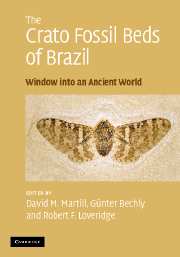Book contents
- Frontmatter
- Contents
- Contributors
- Preface
- Acknowledgements
- Part I The Crato Formation Konservat Lagerstätte
- 1 Introduction to the Crato Formation
- 2 The geology of the Crato Formation
- 3 Stratigraphy of the Crato Formation
- 4 The sedimentology and depositional environment of the Crato Formation
- 5 Commercial exploitation of the Crato Formation
- 6 Preparation techniques for Crato Formation fossils
- Part II The invertebrate fauna
- Part III The vertebrate fauna
- Part IV The flora
- Part V Miscellanea
- Appendix: species list for the Crato Formation
- Systematic index
- Plate section
- References
5 - Commercial exploitation of the Crato Formation
Published online by Cambridge University Press: 22 August 2009
- Frontmatter
- Contents
- Contributors
- Preface
- Acknowledgements
- Part I The Crato Formation Konservat Lagerstätte
- 1 Introduction to the Crato Formation
- 2 The geology of the Crato Formation
- 3 Stratigraphy of the Crato Formation
- 4 The sedimentology and depositional environment of the Crato Formation
- 5 Commercial exploitation of the Crato Formation
- 6 Preparation techniques for Crato Formation fossils
- Part II The invertebrate fauna
- Part III The vertebrate fauna
- Part IV The flora
- Part V Miscellanea
- Appendix: species list for the Crato Formation
- Systematic index
- Plate section
- References
Summary
Despite the varied nature of the Crato Formation succession, comprising a mix of carbonates and silicilastics, only the Nova Olinda Member, the source of the exceptionally preserved fossils, and some of the overlying argillaceous strata, are exploited commercially. The finely laminated limestones of the Nova Olinda Member have been excavated as a building stone, because of the easy way in which they split, and have been used for table tops and paving slabs, probably since historic times.
At present, the Crato Formation is quarried extensively in only two main areas, although in former times small quarries were operated in many places around the Chapada do Araripe, where it was extracted as a source of agricultural lime as well as for building materials. One of the higher laminated limestones of the Crato Formation, the Jamacaru Member, was formerly excavated on the northern flanks of the Serra do Moazina, near Abaiara.
Cement production
To the south and west of Barbalha several large-scale excavations of the Nova Olinda Member limestone and the overlying clays and muddy sands are used in cement manufacture. Quarries formerly operated at Sitio Santa Rita on both sides of the road leading from Barbalha to Jardim, but these sections are now becoming overgrown. A quarry at Sitio Correntinho and the adjacent stream section exhibit a near-complete section of the Crato Formation and are currently the main source of material for cement production at the IBACIP cement works in Barbalha (Figure 5.1a).
- Type
- Chapter
- Information
- The Crato Fossil Beds of BrazilWindow into an Ancient World, pp. 63 - 69Publisher: Cambridge University PressPrint publication year: 2007
References
- 2
- Cited by



